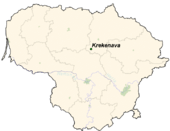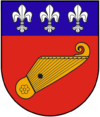Krekenava
| Krekenava | ||
|---|---|---|
| Town | ||
|
Krekenava panorama | ||
| ||
| Coordinates: LT 55°32′28″N 24°05′31″E / 55.54111°N 24.09194°E | ||
| Country |
| |
| Ethnographic region | Aukštaitija | |
| County |
| |
| Population (2001) | ||
| • Total | 2,003 | |
| Time zone | EET (UTC+2) | |
| • Summer (DST) | EEST (UTC+3) | |
| Website | http://www.krekenava.lt | |
Krekenava (Polish: Krakinów) is a town (population 2,003) in Panevėžys district municipality in northern Lithuania, on the bank of Nevėžis.

History
From 1409 it was center of Upytė poviat, 1419 first wooden church built by Vytautas the Great. Nearby Krekanava is a birthplace of the painter Roman Szwoynicki (1845–1915).
In July and August 1941, an Einsatzgruppen of Lithuanian nationalists massacred the Jewish residents of the town, about 50 grownups and 60 children. Along with Jews they also shot so-called Communists and Soviet activists, in all about 190 people.[1] The massacre took place in ditch between the old and the new cemeteries.
Economy
1975 is a year of beginning of JSC “Krekenavos Agrofirma” activities. At a company work over 900 people. “Krekenavos agrofirma” allocates its investments for the two priority fields – improvement of the quality of its activities, and production expansion.
Gallery
 Stone wall near house
Stone wall near house Church
Church- Stairs to the church
 Krekenava 600 year jubilee
Krekenava 600 year jubilee Old house in Sodų st.
Old house in Sodų st.- Nevėžis (river) in winter
 Stage in the pine forest
Stage in the pine forest Dam
Dam Road to Varnakalnis
Road to Varnakalnis Scarp in Varnakalnis
Scarp in Varnakalnis Varnakalnis
Varnakalnis "Girinio" road
"Girinio" road
References
External links
Coordinates: 55°33′N 24°06′E / 55.550°N 24.100°E

